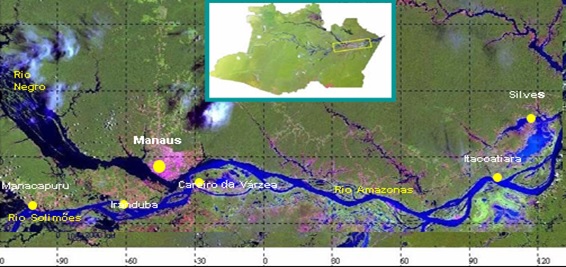Natural fertility of alluvial soils in the Amazon
DOI:
https://doi.org/10.56926/repia.v2i1.32Keywords:
fertility, essential nutrients, crop production, floodplain soilAbstract
A study was conducted on floodplain-covered soils in the Amazonas, Brazil, to compare the fertility of the soil and assess how chemical attributes are distributed throughout various land-use systems. In five municipalities, samples of soil from pastures, secondary forests, and cultivation fields were collected in three depths. To compare the terraforming systems, 12 nutrients were examined, and an experimental factorial design was used. The findings showed that the soils of the flooplain have high concentrations of macro and micronutrients, highlighting the forests as having the highest levels of fertility and the crops as having the lowest levels of C and N. There were differences in the availability of nutrients between secondary forests and agricultural fields. The majority of the land use systems on display had low levels of C and N, confirming that N is a significant limiting factor for agricultural production in the Amazonian floodplain regions. The findings imply that maintaining the soil's fertility in the Amazonian floodplain zones depends on forest preservation.
Downloads
References
Alves Batalha, S. S., Guerreiro Martorano, L., Giaretta Biase, A., Piratoba Morales, G., Nascimento Pontes, A., & Sousa dos Santos, L. (2014). Condições físico-químicas e biológicas em águas superficiais do Rio Tapajós e a conservação de Floresta Nacional na Amazônia, Brasil. Ambiente e Agua - An Interdisciplinary Journal of Applied Science, 9(4). https://doi.org/10.4136/ambi-agua.1304
Ayres, M. I. C., Filha, Z. da R. R., Mota, A. M. da, & Alfaia, S. S. (2018). Efeito da adubação verde no suprimento de nitrogênio para produção de alface em Gleissolo da Amazônia Central [Instituto Nacional de Pesquisas da Amazônia]. https://repositorio.inpa.gov.br/handle/1/35625
Ayres, M. J. (2006). As Matas de Várzea do Mamirauá (3rd ed.). Sociedade Civil Mamirauá.
Centeno, A. J. (1990). Curso de Estatística Aplicada à Biologia (1st ed.). Cegraf Ufg.
Collado-Panduro, L. A., & Alegre-Horihuela, J. (2020). Farming systems on alluvial soils and their impact on the economy of the shipibo-konibo in Ucayali. Manglar, 17(3), 193–201. https://doi.org/10.17268/manglar.2020.029
Dias-Filho, M. B., & Soares de Andrade, C. M. (2008). Pastagens no Trópico Úmido (1st ed.). Embrapa Amazônia Oriental. https://doi.org/10.13140/RG.2.1.1723.5045
EMBRAPA. (1997). Manual de Métodos de Análise de Solo. Centro Nacional de Pesquisa de Solos da EMBRAPA.
Furch, K. (2000). Chemistry and Bioelement Inventory of Contrasting Amazonian Forest Soils. In The Central Amazon Floodplain: Actual Use and Options for a Sustainable Management (1st ed., pp. 109–128). Leiden: Backhuys Publishers.
Irion, G. (1984). Sedimentation and sediments of Amazonian rivers and evolution of the Amazonian landscape since Pliocene times. In The Amazon (pp. 201–214). https://doi.org/10.1007/978-94-009-6542-3_7
Junk, W. J., Piedade, M. T. F., Schöngart, J., Cohn-Haft, M., Adeney, J. M., & Wittmann, F. (2011). A Classification of Major Naturally-Occurring Amazonian Lowland Wetlands. Wetlands, 31(4), 623–640. https://doi.org/10.1007/s13157-011-0190-7
Rios, M. (2016). Agrobiodiversity in the floodplains and its economic function in the Peruvian Amazon. Scientia Agropecuaria, 7, 377–389. https://doi.org/10.17268/sci.agropecu.2016.04.03
Salati, E., Junk, W. J., Shubart, H. O. R., & de Oliveira, A. E. (1983). Amazônia : desenvolvimento, integraçao e ecologia. Conselho Nacional de Desenvolvimento Científico e Technelógico, 327. https://portals.iucn.org/library/node/18082
Santiago, I. N., Piedade, M. T. F., Weiss, B., Demarchi, L. O., & Lopes, A. (2021). Germinação de sementes e morfologia de plântulas de espécies pioneiras da várzea amazônica. Ciência Florestal, 31(1), 271–289. https://doi.org/10.5902/1980509840676
Santos, M. A. S. dos, Lourenço, J. de B., Santana, A. C. de, Homma, A. K. O., Andrade, S. J. T. de, & Silva, A. G. M. e. (2017). Caracterização do nível tecnológico da pecuária bovina na Amazônia Brasileira. Revista de Ciências Agrarias - Amazon Journal of Agricultural and Environmental Sciences, 60(1), 103–111. https://doi.org/10.4322/rca.60103
Scaloppi Junior, E. J. (2007). Propagação de espécies de Annonaceae com estacas caulinares [Universidade Estadual Paulista]. http://hdl.handle.net/11449/105259
Sioli, H. (1984). The Amazon and its main affluents: Hydrography, morphology of the river courses, and river types (pp. 127–165). https://doi.org/10.1007/978-94-009-6542-3_5
Sioli, P. H. (1951). Alguns resultados e problemas da limnologia amazônica. Boletim Técnico IPEAM, 34, 3–44. https://www.embrapa.br/busca-de-publicacoes/-/publicacao/376375/sobre-a-sedimentacao-na-varzea-do-baixo-amazonas
TeixeirA, L. B., & Bastos, J. B. (1989). Nutrientes nos solos de floresta primária e pastagem de Brachiaria humidicola na Amazônia Central. [Empresa Brasileira de Pesquisa Agropecuhria]. http://www.infoteca.cnptia.embrapa.br/infoteca/handle/doc/381186
Teíxeíra, W. G., Lima, H. N., Pinto, W. H. A., Souza, K. W. de S., Shinzato, E., & Schroth, G. (2018). Manejo e conservação do solo e da água. Sociedade Brasileira De Ciência Do Solo, 53(9), 1689–1699. https://rigeo.cprm.gov.br/handle/doc/22016
Valentim, J. F., & Andrade, C. M. S. de. (2009). Tendências e perspectivas da pecuária bovina na Amazônia brasileira. Empresa Brasileña de Investigación Agropecuaria, 4(8), 273–283. http://www.alice.cnptia.embrapa.br/alice/handle/doc/659062
Vieira, R. dos S. (1992). Várzeas Amazónico e a Legislacao Ambiental Brasileira (p. 25). Instituto Brasileiro do Meio Ambiente e Recursos Naturais Renováveis. https://acervo.socioambiental.org/acervo/documentos/varzeas-amazonicas-e-legislacao-ambiental-brasileira
Villacis Fajardo, J. D., Gomes de Souza, L. A., & Sena Alfaia, S. (2009). Características químicas de solos de várzeas sob diferentes sistemas de uso da terra, na calha dos rios baixo Solimões e médio Amazonas. Acta Amazonica, 39(4), 731–740. https://doi.org/10.1590/S0044-59672009000400001

Published
How to Cite
Issue
Section
License
Copyright (c) 2023 Juan Daniel Villacis-Fajardo, Luis Alberto Arévalo-López, Ana María Rengifo-Panduro, Nancy Andrea Villacis-Fajardo

This work is licensed under a Creative Commons Attribution 4.0 International License.
Authors retain their rights:
a. The authors retain the intellectual property rights (copyright) of the published works, assigning to the journal the right of first publication.
b. Authors retain their trademark and patent rights, and also on any process or procedure described in the article.
c. Authors retain the right to share, copy, distribute, perform and publicly communicate the article published in REPIA (e.g., place it in an institutional repository or publish it in a book), with an acknowledgement of its initial publication in REPIA.
d. Authors retain the right to make a subsequent publication of their work, to use the article or any part of it (e.g., a compilation of their work, notes for conferences, theses, or for a book), provided they indicate the source of publication (authors of the work, journal, volume, number, and date).







